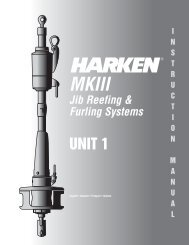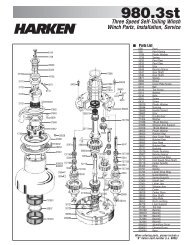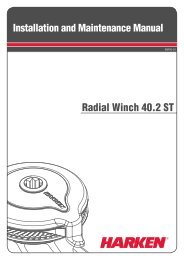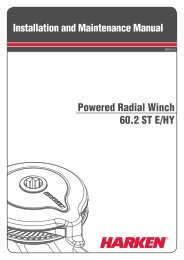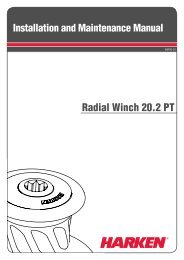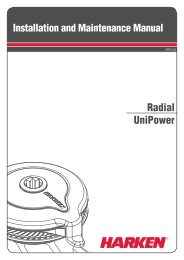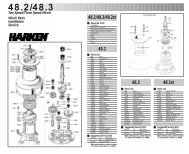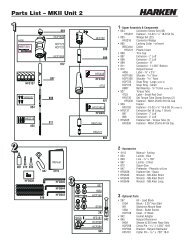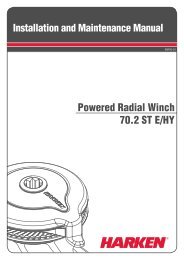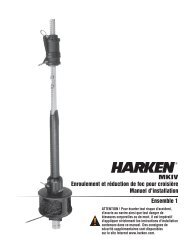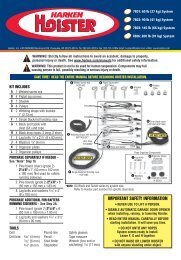Create successful ePaper yourself
Turn your PDF publications into a flip-book with our unique Google optimized e-Paper software.
Commissioning<br />
Halyard: Swivel Height/Lead Angle<br />
Halyard Wrap<br />
The most serious problem with furling systems occurs when the jib halyard<br />
wraps around the headstay foil. Halyard wraps will keep you from furling or<br />
unfurling and may cause serious damage to the unit and the halyard.<br />
WARNING! In severe cases, a halyard wrap can cause loss<br />
of control of boat and/or headstay can break suddenly. Make<br />
sure halyard is clear of top foil before using system.<br />
If Halyard Wraps<br />
If halyard wraps, do not force unit to turn. Attempt to open sail by carefully<br />
furling in and out a little at a time. If sail will unfurl, lower it by releasing jib<br />
halyard. Severe halyard wraps can only be cleared by a professional going<br />
aloft and freeing halyard.<br />
If sail will not furl or unfurl, try to remove jib sheets and manually wrap<br />
sail around headstay.<br />
WARNING! Do not go aloft on boat’s halyards if there has been a halyard wrap. Do not use boat. Damage<br />
to halyard, headstay, stay terminals, or connections as a result of a halyard wrap may cause these parts to<br />
break suddenly causing mast to fall down while person is aloft. Sailing or motoring with boat after a wrap<br />
can result in the headstay breaking and mast falling down. Before using boat, have a professional rigger<br />
inspect and replace parts as necessary using following methods.<br />
A professional rigger must carefully inspect the masthead area using a secure hoisting method. Inform rigger that<br />
there has been a halyard wrap so they can avoid an accident by relying on standing rigging or halyards. Inspection<br />
must be done while rigger is suspended from a separate crane or mast must be lowered to perform inspection. Some<br />
professionals may rig a new line through internal masthead sheaves to serve as a temporary headstay to hold mast in<br />
place. Wire, rod rigging, terminals, toggles, clevis pins, or cotter pins must be inspected and replaced if they show any<br />
signs of damage.<br />
Prevent Halyard Wrap<br />
To prevent wraps, the halyard must exert a slight pull to the rear. This<br />
allows the foils to turn while halyard remains stationary.<br />
WARNING! Sail must be fitted to foil length before using<br />
to prevent halyard wraps and possible headstay loss.<br />
1. Halyard swivel should be within top 4–6" (100–152 mm) of foil unless<br />
a halyard restrainer is used.<br />
2. Halyard must pull slightly to rear (8–10°).<br />
3. Halyard must be snug, but not too tight.<br />
Test furler at dock, but if water is smooth an incorrect lead angle may not<br />
be apparent. Halyard wraps usually occur in wave action when lead angle<br />
is not correct. The 8–10° angle shown at right is critical.<br />
8–10°<br />
36 MKIV Underdeck <strong>Unit</strong> 1, 2, 3






